John R. Phythyon Jr.'s Blog, page 6
July 29, 2015
Latest Mini-Memoir, “Are We There Yet?” Available
Summer vacation season is fully upon us in the U.S. Time to hit the lake or the beach or Grandma’s house.
When I was growing up in the 1970’s, summer vacation meant a long road trip to one of two different destinations — Dayton, Ohio, to visit my dad’s parents, or Kennebunkport, Maine, where my mom’s family had a summer cottage. My brother, my dog, and I would be packed unsafely into the back of my dad’s station wagon (we put the seat down to make a bed, so there were no seat belts), and then carried across hundreds of miles of the American roadway en route to good times.
Getting there was not half the fun.
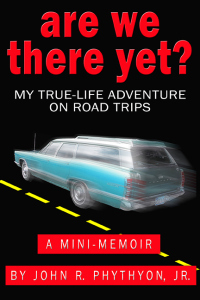 My latest mini-memoir, “Are We There Yet?: My True-Life Adventure on Road Trips,” details some of the misadventures we had on the way to Ohio and Maine. “Highlights” include an unfortunate encounter with truck stop food, a terrifying attempt to cross a gorge-spanning bridge, and the death and rebirth of Batman. As usual, all these stories are both outrageous and true.
My latest mini-memoir, “Are We There Yet?: My True-Life Adventure on Road Trips,” details some of the misadventures we had on the way to Ohio and Maine. “Highlights” include an unfortunate encounter with truck stop food, a terrifying attempt to cross a gorge-spanning bridge, and the death and rebirth of Batman. As usual, all these stories are both outrageous and true.
You can get “Are We There Yet?” for only 99 cents for Kindle by clicking here.
To celebrate the release of my sixth mini-memoir (they’re all only 12,000 to 15,000 words long, so they read quickly), I’m offering two of them for free today — “Secret Identity: My True-Life Adventure as a Superhero” and “Rocketed to Earth: My True-Life Adventure as a Space Alien.” Click the links below to get them.
Thanks for reading and may your summer travel be less eventful than the adventures I detail in “Are We There Yet?”.
Click here to get “Are We There Yet?: My True-Life Adventure on Road Trips” for 99 cents.
Click here to get “Secret Identity: My True-Life Adventure as a Superhero” for FREE!
Click here to get “Rocketed to Earth: My True-Life Adventure as a Space Alien” for FREE!
Filed under: Uncategorized


July 21, 2015
An Unexpected “Reunion”
You never know how you’re going to influence someone. Oftentimes, it happens when you don’t even know about it.
Saturday night, I went to see Pickerington Community Theatre’s production of 1776. If you’re not familiar with the show, it tells the story of the Continental Congress in 1776 and the writing and adoption of The Declaration of Independence. As you might imagine, it was very popular in the 1970’s, particularly in 1976, when America was celebrating its bicentennial.
It’s not performed as often now. It was never one of those blockbuster shows that everyone knows and loves like The Sound of Music, Fiddler on the Roof, or Wicked.
And despite the fact that much of the action takes place in a single room with the actors sitting in chairs, it’s a difficult show to stage for community theatres. Virtually all of the parts are played by men. There is a small, but significant role for John Adams’s wife, Abigail, and Martha Jefferson has what amounts to a cameo.
Otherwise, it’s all men, all the time, and theatre participation runs on a ratio of roughly two women to every one man. Thus, trying to find enough men to get up on stage wearing wigs and frilled collars is hard. Trying to find enough who can also sing and act is a monumental undertaking.
The musical retelling of the birth of our nation is therefore not in heavy rotation with amateur theatre companies.
I was at the show for two reasons. First, I’m directing PCT’s production of A Little Princess, a stage adaptation of the Frances Hodgson Burnett novel, this fall, and since this is my first time working with the company, I wanted to attend a current show to see how they work. I’ve been to a board meeting and met their principals, so I wanted to see them in action.
Secondly, I was in 1776 as a junior in high school. I went to an all-boys Catholic high school with a strong arts program, so it was not only possible but easy to put enough males onstage as the Founding Fathers. I was cast as Robert Livingston of New York — a minor role in the overall plot, but with a nice solo in the charming and amusing song, “But, Mr. Adams.” I thought it would be fun to see a show I had not seen in the 30 years since I’d been a part of it.
I contemplated auditioning for PCT’s production for both nostalgia’s sake and to make some new friends, but I was just too busy this summer to make it work.
After seeing the show on Saturday night, I wish I’d found a way.
If you’ve never been to a community theatre performance, most of them have a pre-show speech. The director or an executive from the organization comes out and gives you the rundown about no photography and the cast being available for meeting afterward. Often, they mention a fundraising effort, since they are universally nonprofit businesses.
PCT was no exception, and the director mentioned in his speech that he had loved 1776 since he first saw it as a little boy in 1985. I thought, Wow! That’s the same year I was in it in high school! What a coincidence.
Then he went on to say that the production he saw was in Green Bay, Wisconsin. His uncle played John Adams.
My heart stopped. Remember: 1776 is not performed very often. And, though my memory of everything that was happening while I was in high school is a little hazy, I am dead certain there were no other productions of 1776 running in my hometown in ’85.
I turned to my wife with my mouth hanging open. I told her who the director’s uncle was.
At intermission, I found the director, whom I’d met at the PCT board meeting and friended on Facebook shortly thereafter. I asked him his uncle’s name. When he told me what it was, I nodded.
“Dude, I was in that production of 1776 you saw,” I said.
We stood there speechless. Neither of us knew how to express our amazement. This trip down Memory Lane was suddenly very different.
How fun would it have been to actually have been in this production? What if I’d been cast as Livingston again? What if I’d been good enough to get Adams, especially since his uncle traveled to Ohio to see the show on opening night?
The what-ifs are almost more incredible than the actual circumstances. Almost.
I enjoyed 1776 a lot. It is a better show than I remembered. I delighted listening to “But, Mr. Adams.” I could still see my schoolmates up there onstage. It was a nice evening out.
But it was made more amazing by the revelation that we do live in a small world. Fate and circumstance brought two people who had never met back together.
You just don’t know how or where you’ll influence people. But if you’re lucky, you get to find out every now and then.
Filed under: Uncategorized


June 30, 2015
A CONTEST OF SUCCESSION Available
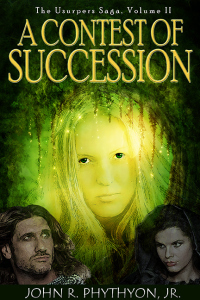 I’m pleased to announce my latest, novel, A Contest of Succession, is now available for Kindle at Amazon.com.
I’m pleased to announce my latest, novel, A Contest of Succession, is now available for Kindle at Amazon.com.
Garrick Tremaine was living a happy life as a soldier in Lord Malach’s army, when the Duke of Twin Falls visits him in a dream and tells him he can find his destiny in Twin Falls.
When he arrives,though, Garrick discovers the duke has died and there is a contest to succeed him. Anyone can enter, but to win requires answering a nearly incomprehensible riddle. Pushed to enter the contest by his new friend, the odd sorcerer, Liliana Gray, Garrick finds himself at odds with eight other contestants in a savage game with more at stake than he realizes.
The book is a sequel to my 2013 fantasy, The Sword and the Sorcerer, but you don’t have to have read SatS to understand what happens in A Contest of Succession. (Of course, if you want to read the first book, and you haven’t, The Sword and the Sorcerer is free for Kindle through Wednesday, July 1. Get it here.)
A Contest of Succession is an epic fantasy. Click here to get it for $2.99 for Kindle. A print edition will be available in July.
Filed under: A Contest of Succession Tagged: Contest of Succession, John Phythyon, Kindle, Usurpers Saga


June 27, 2015
Love Wins
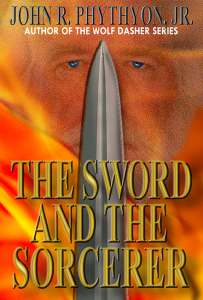 I published The Sword and the Sorcerer in December of 2013. The novel has a gay couple as its protagonists, so I’ve been donating a dollar from each sale or borrow to Freedom to Marry, a national nonprofit dedicated to advocating and fighting for marriage equality in the United States.
I published The Sword and the Sorcerer in December of 2013. The novel has a gay couple as its protagonists, so I’ve been donating a dollar from each sale or borrow to Freedom to Marry, a national nonprofit dedicated to advocating and fighting for marriage equality in the United States.
On Friday, June 26, 2015, the U.S. Supreme Court at last ruled that state bans on gay marriage are unconstitutional. Lesbian and gay couples can now wed and be afforded all the same rights as heterosexual couples.
To celebrate this landmark ruling, I’m offering The Sword and the Sorcerer for free for the first time. You can get it for your Kindle-enabled device at http://bit.ly/SatSKindle.
I’m so pleased to have been a tiny part of this historic moment, and I’m ecstatic for my LGBT friends who now have equal protection under the law.
There remains a lot of work to be done. LGBT citizens may now have the right to marry, but a court ruling doesn’t eliminate bigotry and hatred. Our culture is changing, but it’s not fully evolved yet.
For the moment, though, it’s time to pause and celebrate. So have a free book (and maybe a little champagne).
Love wins.
Filed under: Current Events, The Sword and the Sorcerer


June 18, 2015
Re-Viewing James Bond: Diamonds Are Forever
Travel and conventions have kept me tied up recently, so I’ve struggled to post to the blog, especially on my regular series on all the Bond films. I’m back today, though, with a look at 1971’s Diamonds Are Forever — Sean Connery’s brief return to the role of 007 in the official Eon Pictures movies.
As usual, I’ll look at the film and its impact on the series, so there are spoilers.
The Plot
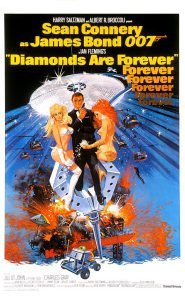 Diamonds Are Forever opens with a bloody-minded Bond attempting to run down Ernst Stavro Blofeld after the fiend murdered Bond’s newlywed bride at the end of the previous film, On Her Majesty’s Secret Service.
Diamonds Are Forever opens with a bloody-minded Bond attempting to run down Ernst Stavro Blofeld after the fiend murdered Bond’s newlywed bride at the end of the previous film, On Her Majesty’s Secret Service.
He eventually locates him having plastic surgery to alter his appearance. After a brief fight, Bond ties Blofeld to a gurney and rolls him into a tarpit, killing him.
With Blofeld dead, MI6 assigns Bond to a diamond-smuggling case that begins in South Africa, moves to Amsterdam, and eventually ends in Las Vegas. Not only has there been a rise in diamonds disappearing, everyone connected to the operation ends up dead.
Bond infiltrates the operation, where he meets the lovely and fast-talking Tiffany Case. With her help, he smuggles the diamonds into the U.S., but the homosexual assassins, Wint and Kidd, make several attempts to kill 007, all of which nearly succeed.
Bond discovers that Blofeld is still alive, and that he has made a double of himself — hence the plastic surgery. It was another double that Bond killed earlier in the film.
Blofeld is masquerading as reclusive billionaire, Willard Whyte, and is running the smuggling operation. He needs the diamonds for a satellite laser that he intends to use to blackmail the world’s most powerful nuclear nations — U.S., U.S.S.R., and China — into paying a ransom for nuclear superiority. The country that bids highest will not have its nukes destroyed and will therefore become foremost on the world stage.
Bond makes it to Blofeld’s hideaway, organizes a commando raid with the help of longtime friend Felix Leiter, and destroys the operation, with Blofeld left to an uncertain fate.
The Feel
This is the first bad James Bond film, and there are a lot reasons why.
After firing George Lazenby, the producers were desperate to find a new Bond, who could quickly find appeal with audiences. Roger Moore and Timothy Dalton (both of whom would later get the part) were considered for the role, but Moore had television obligations and Dalton felt he was too young.
In the end, they approached Sean Connery. He refused until he was offered a king’s ransom to do it. With Connery back in the role, the producers attempted to recreate the feel of Goldfinger.
But there were several problems with Connery. First, he was too old for the part. He looks older in multiple scenes, and playing opposite a young Jill St. John didn’t do his looks any favors.
Second, Connery didn’t offer any of the emotional resonance Lazenby would have. He gives the impression that Bond kills Blofeld because he’s a bad guy — not because he’s plagued the world with multiple nefarious schemes and certainly not because he murdered Bond’s wife. There just isn’t any of the raw anger and loathing one would expect in a sequel to a movie where the protagonist’s wife is killed and the murderer is still on the loose.
Finally, Connery didn’t want to do this picture. His performance is empty. Not only does he have no emotional connection to Blofeld, he doesn’t seem to have any connection to the film at all. He’s phoning in this performance.
Next is Blofeld himself. Charles Gray’s rendition is all wrong. Donald Pleasance’s Blofeld was sinister, frightening. Telly Savalas’s was powerful, dominating, and brutal. Gray plays Blofeld like a fop. He’s more of a comical villain, which further contributes to the disconnect from the idea that Bond should want this guy dead for murdering his wife.
Moreover, why the hell is Blofeld making copies of himself? What possible advantage is there to that and what does it have to do with the rest of the story? It seems to fit in line with the 1970’s fascination with the idea of cloning, but the only purpose the plot point serves is to make us think Bond killed Blofeld before, only to have him come back again.
Connery’s return also means the return of his sexism. We have the ridiculously named character, Plenty O’Toole, so Connery can quip, “Named for your father, I suppose.” When Tiffany Case makes the wrong switch of a cassette tape to foil Blofeld’s plan, Bond calls her a stupid twit.
And then there’s Bambi and Thumper — two nubile bodyguards named for Disney characters that Bond has to fight to release the real Willard Whyte. They at least get some good licks in before he defeats him, but it’s still silly.
And speaking of silly, the stunts in this film are terrible. Bond steals a moon buggy and is chased across the Nevada desert in one of the most preposterous scenes in the franchise. Worse, he escapes down an alley by putting a Mustang fastback on its two right wheels, but when the car emerges from the alley, it’s on its left wheels.
The best part of the film is Wint and Kidd. The two lovers are clever and witty. Each kill is executed with a quip, and Bruce Glover and Putter Smith seem to delight in the roles. Every scene they are in is fun to watch . . . unlike much of the rest of the film.
Where It Fits
Diamonds Are Forever is easily the worst of the first seven James Bond films, and it’s Connery’s only stinker. Since its release in 1971, several other entries in the series have challenged it for Worst Bond Film of All Time (notably 1974’s The Man with the Golden Gun, 1985’s A View to a Kill, and 2002’s Die Another Day), but DAF makes a credible argument for the crown.
It’s too bad. The book is terrific, and there are echoes of the novel in the movie plot. It also had the potential to be a really emotionally powerful film, following On Her Majesty’s Secret Service, but since OHMSS was considered a box office disappointment and Lazenby had proven impossible to work with, the producers steered away from a serious picture and went for camp and fun instead.
What they got as a result is an entirely forgettable film that made for a disappointing swan song for Connery, and a piece that does not stand up well over time.
Diamonds Are Forever is hard to watch. I own it for completeness sake, but I only rarely put it in.
Filed under: James Bond Tagged: Diamonds Are Forever, James Bond, Sean Connery


June 3, 2015
Inspirations: Role-playing Games
With the Origins Game Faire set to kickoff here in Columbus this weekend, I thought this would be a good time to check in with my occasional series, “Inspirations,” in which I discuss the influences that made me the writer I am today. So here’s a look at how certain tabletop role-playing games helped put me on the road to becoming a fantasy author.
In the beginning . . .
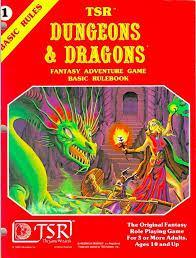 The vast majority of who find their way into RPG’s do so through Dungeons & Dragons. I was no exception. I began playing the seminal game about invading the lairs of monsters, killing them, and taking their gold in 1982. My brother David got the red-boxed Basic Set for his birthday that year. Before long we were rolling up characters and getting started.
The vast majority of who find their way into RPG’s do so through Dungeons & Dragons. I was no exception. I began playing the seminal game about invading the lairs of monsters, killing them, and taking their gold in 1982. My brother David got the red-boxed Basic Set for his birthday that year. Before long we were rolling up characters and getting started.
If you’re not familiar with RPG’s, they’re a kind of cooperative storytelling exercise, where each player controls a character in some form of fantasy environment, and an extra player — the dungeon master or game master — plays all the adversaries, sets up the adventures, and acts as a rules arbiter.
Fancying myself something of a storyteller from an early age, I quickly became enraptured with the idea of being the dungeon master (“DM” in the parlance of the game). Our first campaigns were little more than excursions to kills monsters and gain power.
But within a year, I was running a (slightly) more sophisticated narrative that emulated the fantasy novels I was reading at the time. This campaign was wholly derivative of The Lord of the Rings, the Dungeons & Dragons cartoon, Stephen Donaldson’s Thomas Covenant series, and pretty much every bad fantasy flick made between 1981 and 1986. The stories were not original.
But they were undeniably stories, and this was my first real experimentation with archetypes and epic. I didn’t even know what those words meant in a literary sense at the time, but I was tapping into them as I plotted imaginary high adventure for my friends and I.
As much as I adored fantasy literature, it was another game and genre that would push me forward another step in my development as a writer: superheroes, specifically, Marvel Comics superheroes.
Emulating Comics
 I played a lot of different RPG’s in the early to mid-80’s in addition to D&D. But the one that stuck with me the most was the original Marvel Superheroes from TSR. Published by the same company that made D&D, the game had an incredibly simple action resolution system that made playing in the four-color world of Marvel Comics.
I played a lot of different RPG’s in the early to mid-80’s in addition to D&D. But the one that stuck with me the most was the original Marvel Superheroes from TSR. Published by the same company that made D&D, the game had an incredibly simple action resolution system that made playing in the four-color world of Marvel Comics.
Best of all, you didn’t have to play the Marvel characters. You could make up your own.
So Dave, my friends, and I set to creating our own unique and famous superheroes and setting their adventures smack in the Marvel Universe. So not only did we struggle against home-brew villains like Heatwave and Alkaline, we also took on Galactus and Dr. Doom.
Naturally, the game inspired us to look at the source material, and for the first time since I’d been a little kid, I started buying comic books. By the time I graduated from college, I was reading 30 titles a month.
The more I read, the more I wanted to write comics, and I accomplished that by two means. First, I played a lot of Marvel Superheroes with my friends.
Second, and perhaps more importantly, I would “write” comic books in my mind, and then tell them to my friends. Each month, a new issue of the comics I was writing would come out, and my friends would gather to listen to what Captain Cosmos and his friends were up to now.
We had several Marvel Superheroes campaigns going at once, with each of us running a different one, and each of these was a comic book too. Throughout my college years, my friends and I created an entire universe of imaginary comic-book heroes, and the lore of these are still related when we get together some 25 years later.
For a short time, I dreamed of becoming a comic writer, but I went to graduate school instead. There, I played two games that would have a profound impact on my ultimate development as a writer: James Bond: Role-playing on Her Majesty’s Secret Service and Vampire: The Masquerade.
Graduate Work
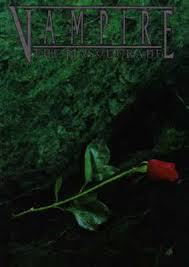 I moved to Kansas for grad school and acquired a new group of friends. They were into this new game called Vampire from a small company in Stone Mountain, Georgia, named White Wolf Games Studios. In the game, you played a creature of the night, but instead of being a neck-biter in a B-movie, you were a tragic creature along the lines of Frankenstein’s Monster or the Phantom of the Opera, wishing for a life of peace and love but doomed to a wretched existence of eternal torment.
I moved to Kansas for grad school and acquired a new group of friends. They were into this new game called Vampire from a small company in Stone Mountain, Georgia, named White Wolf Games Studios. In the game, you played a creature of the night, but instead of being a neck-biter in a B-movie, you were a tragic creature along the lines of Frankenstein’s Monster or the Phantom of the Opera, wishing for a life of peace and love but doomed to a wretched existence of eternal torment.
There were two very important emphases in the game. The first was personal horror. Players were supposed to create a backstory for the character that was full of anguish and personal loss. The game made it clear the titular vampires were monsters and almost certainly unworthy or incapable of redemption.
The second was on story. Indeed, the game master was called the storyteller. Vampire: The Masquerade very specifically encouraged the introduction of literary themes, plot, conflict — all the elements of a novel or film.
Consequently, I applied story structure to my games. When I ran my own Vampire campaign, we met weekly, and so it became natural to think of if as a TV series, with the players as the star actors. I constructed an epic storyline that arced through three “seasons,” and there was a huge payoff at the end. I wrote an introduction for each session, which I read the players as a setup before beginning play. The oral tradition I began with my college friends morphed into a fully collaborative story with beginning, middle, and end.
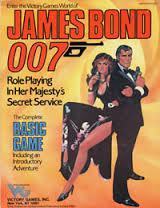 At the same time, I was introduced to the James Bond game. This under-appreciated masterpiece was the first RPG I’d encountered where the rules of the game were designed to emulate the genre. The Bond game played like a Bond movie, where it was easier for the hero to pull off the impossible than for the nameless thugs to do the average.
At the same time, I was introduced to the James Bond game. This under-appreciated masterpiece was the first RPG I’d encountered where the rules of the game were designed to emulate the genre. The Bond game played like a Bond movie, where it was easier for the hero to pull off the impossible than for the nameless thugs to do the average.
Each adventure was supposed to be a single Bond film, and after the first one, I was instantly hooked. But I felt something was missing, and the genre-emulation I learned from Marvel Superheroes and Vampire: The Masquerade led me to start recording music. I’d get the name of the adventure from the GM, and then write a theme song along with an action-chase piece and a sneaking-around piece that riffed on the main melody from the theme.
Amazingly, I churned out Bond-style music for our role-playing sessions on a weekly basis throughout the summer of 1992. And again, my sensibilities were totally focused on making sure our games were properly reflecting the genre in which they were set.
Into the future . . .
I gamed well into my 30’s and designed RPG’s for a living for eight years, applying the principles I’d learned playing them in my youth.
Eventually, I figured out that I was spending my creative energy writing stories for five or six people instead of writing them down and publishing them for the whole world. I quit playing RPG’s and spent my time learning to write novels.
But I learned to work with archetypes from D&D, emulate genre from Vampire and James Bond, and the elements of an exciting story from Marvel Superheroes. I may not play the games anymore, but they taught me a lot about crafting adventures for my readers.
The clatter of a 20-sided die still makes me smile, and sometimes I put in the tapes of those old James bond themes I recorded and lose myself down Memory Lane.
Games were good to me. They provided hundreds of hours of entertainment, and they helped make me the writer I am.
Filed under: Inspirations Tagged: Dungeons & Dragons, James Bond, John Phythyon, Marvel Superheroes, Vampire the Masquerade


May 27, 2015
Re-Viewing James Bond: On Her Majesty’s Secret Service
My re-examination of the James Bond film series rolls on this week. Today, I’m looking at 1969’s On Her Majesty’s Secret Service — the first Bond flick without Sean Connery as 007. As usual, there are spoilers, so be advised if you haven’t seen it.
The Plot
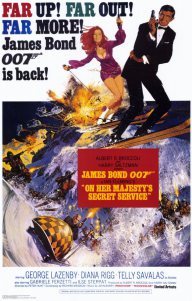 James Bond has spent the last two years searching for Ernst Stavro Blofeld, the head of S.P.E.C.T.R.E who escaped at the end of You Only Live Twice. When the film opens, Bond is in Southern France. He encounters a beautiful woman in a Mercury Cougar, who roars by him on the road, but then stops at a beach and attempts to drown herself in the ocean.
James Bond has spent the last two years searching for Ernst Stavro Blofeld, the head of S.P.E.C.T.R.E who escaped at the end of You Only Live Twice. When the film opens, Bond is in Southern France. He encounters a beautiful woman in a Mercury Cougar, who roars by him on the road, but then stops at a beach and attempts to drown herself in the ocean.
Bond rescues her but is assaulted by two armed men after getting her ashore. He defeats them in one of the best fistfights in the entire series, but while he’s doing that, the woman steals his car to get up the beach, gets into her own car, and drives off without even saying thank you.
When Bond gets to his hotel, he meets the woman again while playing chemin de fer. She bancos, loses, and then tells the croupier she doesn’t have any money. Bond rescues her again, this time by paying her debt.
Her name is Countess Teresa di Vincenzo, and she gives Bond the key to her suite to repay him for his kindness. When he shows up, though, Tracy, as she is known, is not there. Instead, there is a man who attempts to kill Bond.
After defeating him, Bond returns to his own suite, where Tracy surprises him, threatening to kill him with his own gun. After he disarms her, he tries to help her, telling her he thinks she’s in trouble. But Tracy is evasive, won’t answer any questions, and makes love to him to change the subject.
When he wakes the next morning, she’s gone. On his way out to play golf, Bond is kidnapped by thugs, including the man he fought in Tracy’s suite the night before, and driven to Italy, where he meets Marc-Ange Draco, head of the Union Corse and Tracy’s father.
Draco has an unusual proposal for Bond. Tracy is widowed, rebellious, and self-destructive. But Draco has been informed of how Bond has protected her, so he suggests that Bond should woo and marry her. He believes what Tracy needs is a man to tame her headstrong ways. He offers a million-pound dowry.
Bond declines at first, but it occurs to him that Draco might have leads on where to find Blofeld, so he agrees to see Tracy in exchange for any information Draco can dig up.
Afterwards, he returns to London, where M informs him the mission to find Blofeld is dead and that Bond will be reassigned. Furious, Bond resigns from Her Majesty’s Secret Service. But Miss Moneypenny saves the day by changing 007’s letter of resignation to a request for two weeks’ leave.
Bond uses the opportunity to meet with Draco to get a lead on Blofeld and to date Tracy. She quickly falls in love with him, and Draco uses his operation to help Bond discover that Blofeld is posing as Count Balthazar de Bleauchamp. He has written to the College of Heraldry in London asking to have his claim to the title of Count recognized.
Bond recognizes “Bleauchamp” as the French form of “Blofeld.” He reads up on heraldry and asks M to reassign him to the case. Bleauchamp agrees to a meeting with the college’s Sir Hilary Bray, and Bray agrees to have Bond impersonate him, so they may discover if his alleged Count de Bleauchamp is in fact Blofeld.
Posing as Sir Hilary, Bond flies to Piz Gloria in the Swiss Alps, where Count de Bleauchamp has established an allergy research institution. There, he takes on beautiful female patients from all over the world, curing them for free in exchange for their participating in his experimental tactics.
Being the womanizer he is, Bond sleeps with several of the clinic’s patients while conducting his investigation. But this proves fruitful as he discovers Count de Bleauchamp’s cure includes post-hypnotic suggestion and that some rather strange instructions are being implanted in the women’s subconsciouses.
He gets caught, though, when he attempts to lure the count away from the clinic by bringing him to the ancestral home of the Bleauchamps for research. Bond gets some of the details wrong, and Blofeld takes him into custody.
With Bond in his power, Blofeld reveals his master scheme. Not only has he developed a psychological cure to most allergies, he’s also perfected a virus that will induce total infertility in a species. Via post-hynoptic suggestion, he plans to use his patients as “angels of death,” dispensing his deadly agent unless his price is met — a full pardon for all his past crimes and his title as Count de Bleauchamp recognized.
The patients are sent home on Christmas Eve, and Bond manages to escape. But he is hounded by Blofeld’s sinister minions in the village below and can’t find a way out until Tracy shows up. She asked her father where Bond was and went to Piz Gloria to wait for him.
The two are pursued out of town by Blofeld’s people, and eventually escape temporarily. But they are forced to take shelter in a barn when a blizzard makes travel impossible.
There, Bond realizes he’ll never meet another girl like Tracy and asks her to marry him. She agrees.
The next morning, though, Blofeld catches up to them. He and his men pursue the couple on skis, and Blofeld starts an avalanche to bury them. He can see Tracy unconscious in a pile of snow, so he orders his men to grab her and bring her back with them.
Bond emerges a minute later, but it’s too late. Blofeld and Tracy are gone.
In London, M tells Bond that the Western governments have agreed to pay Blofeld’s ransom. Bond suggests they can get to Piz Gloria ahead of the deadline and take him out, but M rejects the plan, saying it is too risky.
So Bond turns to his future father-in-law for help again. Masquerading as a Red Cross mercy flight, Draco, Bond, and the Union Corse raid Blofeld’s facility, rescue Tracy, and destroy the operation. Bond pursues Blofeld in a bobsled chase that results in Blofeld getting clothes-lined by a forked tree branch that seemingly kills him.
In the film’s epilogue, Bond marries Tracy and the two drive off for a honeymoon. But when they stop on the side of the road to remove the flowers from the car, Blofeld, who isn’t dead after all, drives by and tries to shoot Bond. He misses and kills Tracy instead. The picture ends with a weeping Bond holding Tracy and saying, “We have all the time in the world.”
The Feel
As you can see from the overly long plot synopsis, On Her Majesty’s Secret Service is a deeply complex film with multiple plot threads running through it. There hasn’t been a Bond movie this complicated since 1963’s From Russia With Love, and none of the previous five films are this emotionally intricate. From a story perspective alone, this is a very satisfying film.
It’s not possible to discuss the picture in any context without addressing the fact that this is George Lazenby’s one and only turn as Bond. Continuing a film series with a new actor in an iconic role was something of a new idea at the time, and the producers go out of their way to establish that On Her Majesty’s Secret Service is indeed the sequel to You Only Live Twice, even though there’s a new guy in the part.
The opening title sequence is a collage of scenes from the first five movies in the series. When Bond resigns from MI6, he starts cleaning out his desk and comes across artifacts from previous adventures — Honey Ryder’s knife, Red Grant’s garotte wristwatch, and his own portable rebreather from Thunderball.
The producers even have a sense of humor about the change. After Tracy deserts him on the beach following Bond rescuing her in the pre-title sequence, Lazenby looks straight into the camera and says, “This never happened to the other fella.”
As much as On Her Majesty’s Secret Service attempts to establish itself as part of the same milieu as the Connery films, Lazenby’s take on the character is very different than his predecessor’s. He’s a much more lighthearted Bond. He quips more. He emphasizes Bond’s playboy attitude more than his coldblooded killer aspect.
Connery’s Bond was a killer masquerading as a socialite. Lazenby’s is a dandy, who kills when necessary. They both have a good understanding of Bond’s character, but they emphasize completely different traits.
But despite Lazenby’s lighter approach, he’s also a lot more two-fisted than Connery. His thrilling battle with Red Grant on the train in From Russia With Love notwithstanding, most of Connery’s fistfights were short and slow.
Lazenby throws a lot of punches in On Her Majesty’s Secret Service. Director Peter Hunt uses lots of cuts to speed up the action as well. Lazenby’s fights are frequent and breathless.
In the same vein, Telly Savalas’s Blofeld is a physical match for Bond. In every other movie Blofeld has appeared in, he has been withdrawn, unreachable, a genius who pets his cat while ordering the deaths of others.
Savalas does all that, but he is also a formidable physical presence. Donald Pleasance takes a single shot at Bond in You Only Live Twice, and is foiled by a well-placed shuriken from Tiger Tanaka. Savalas, wrestles with Bond as the two scream down a mountain in a bobsled. He is strong enough to hold Bond’s head against the side of the chute and has the upper hand in their fight until he is fortuitously disabled by a tree branch. Much like with Largo in Thunderball, Bond is overmatched until he gets some unexpected help.
Finally, the stunts are a lot more dramatic. Aside from the scuba-diving he does in Thunderball, the ski chase down the Swiss Alps is the first time we’ve seen Bond engage in really vigorous physical activity. But skiing is faster and more dramatic than simming. Much of the action is filmed with real skiers instead of in a studio with a blue screen.
Likewise, while there is some studio work in the car chase where Tracy rescues Bond, there is a lot of live action, particularly the sequence where our heroes and the villains pursuing them interrupt a stock car race on an icy track.
This is a high-octane picture, and Hunt doesn’t take his foot off the gas for very long, particularly as the film enters its third act.
Where It Fits
Sadly, George Lazenby got a lot of bad advice about acting. He was a model before landing the role of Bond, and he frequently showed up late and acted like an idiot, because his friends told him that’s what star actors were supposed to do. Consequently, he got fired after only one film.
It’s too bad on several fronts. First, he was really good as Bond. Though his take on the character is different than Connery’s, it’s fun, authentic, and entertaining. Lazenby wasn’t as handsome as Connery, but he was every bit as charming, if not more so. His athletic, two-fisted style would have been very appealing in future films. Indeed, Bond doesn’t engage in this level of athleticism again until Daniel Craig takes over the role in 2006’s Casino Royale.
Additionally, On Her Majesty’s Secret Service often gets overlooked as a truly fine Bond film. As I mention above, few of the movies in the franchise have as complex and emotionally rich a plot as OHMSS. Lazenby has real chemistry with Diana Rigg as Tracy, and strong, smoldering spite with Telly Savalas’s Blofeld. His performance drives the picture, and he would have made a terrific Bond had he continued in the role.
It would have been interesting to see how the series developed with Lazenby as Bond through four or five more films. One can imagine Diamonds Are Forever and The Spy Who Loved Me being very different movies if the actor who had played the part in the film where Bond’s wife is assassinated were reprising it in those stories, where she is directly mentioned.
Instead, On Her Majesty’s Secret Service is a blip on the radar of the Bond franchise. It is one of the very best films in the series, but it is often forgotten, along with the actor who briefly played the world’s most famous spy.
Filed under: James Bond Tagged: George Lazenby, James Bond, On Her Majesty's Secret Service


May 20, 2015
Re-Viewing James Bond: You Only Live Twice
My regular series on the James Bond franchise rolls on this week with a look at 1967’s You Only Live Twice. As usual, I’m examining the film’s plot and seeing how it views today, so there are spoilers.
The Plot
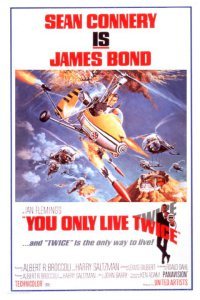 Two years before the U.S. successfully lands a man on the moon, an American space capsule is in orbit around Earth. Suddenly, a second larger spacecraft comes up behind it and and swallows it whole.
Two years before the U.S. successfully lands a man on the moon, an American space capsule is in orbit around Earth. Suddenly, a second larger spacecraft comes up behind it and and swallows it whole.
The Americans blame the Soviets, who deny all knowledge. The British suggest that the other capsule came down somewhere in the Sea of Japan and that the investigation should be focused there. The U.S. is unconvinced, certain the Russians are behind it.
James Bond is assigned the case. But first, a fake assassination is staged, so his enemies will think he’s dead.
Bond is sent to Tokyo, where he meets with the head of the Japanese Secret Service, Tiger Tanaka, and his beautiful agent, Aki. The clues point initially to an industrialist named Osato, who has been ordering chemicals to make rocket fuel.
With Aki’s help, Bond traces Osato to a small, volcanic island populated, it seems, exclusively by rural fishers. He knows something is up, because while reconnoitering the island by air, he is attacked by four helicopters with machine guns.
Meanwhile, the Soviets launch a space capsule, and it is stolen in the same fashion as the Americans’. Both sides are fully ready to start a nuclear war at the next provocation.
With the clock ticking towards the next American space launch, Tiger concocts a plan to disguise Bond as a Japanese and marry him to one of his agents on the island — Kissy Suzuki — in the hopes that they can discover the island’s secret before it’s too late. Before the “marriage,” two assassination attempts are made on Bond, the first of which kills Aki by mistake.
Once he’s in place undercover, Bond and Kissy discover an islander died under mysterious circumstances after sailing her boat into a cave. When they investigate, they discover that a volcano thought to be extinct actually hides the secret base of Bond’s longtime nemesis, S.P.E.C.T.R.E.
This time, the fiends have been hired by rogue elements in the Japanese government to spark a war between the U.S. and Soviet Union that will result in the two superpowers annihilating each other, so Japan can rise as a new world power.
We finally meet S.P.E.C.T.R.E. Number One — Ernst Stavro Blofeld, played chillingly by Donald Pleasance. He looks forward to personally killing Bond.
But Tanaka arrives in the nick of time with a team of ninjas, and Blofeld’s scheme is foiled just before the U.S. space capsule can be stolen, thereby averting war. S.P.E.C.T.R.E.’s operation is smashed, but Blofeld escapes.
The Feel
“This is the Big One, 007,” M tells Bond before he leaves on assignment. In Goldfinger, there was one atomic bomb that was supposed to irradiate the U.S.’s gold supply. In Thunderball, there were two bombs that would be exploded if a ransom wasn’t paid.
But in You Only Live Twice, the threat is all-out nuclear war between the superpowers. If Bond fails this time, the world as we know it will be destroyed.
That ratchets up the tension in this adventure. 007 absolutely cannot fail.
You Only Live Twice also gives us a truly exotic location for the first time. Bond went to Istanbul in From Russia with Love, which would have been something many viewers hadn’t seen before, but the gypsy character of the setting is at least familiar to most audiences. Dr. No and Thunderball have Caribbean settings, and Goldfinger is set largely in the U.S.
But YOLT takes us to Japan. Through the exposition of Tiger Tanaka, we learn about the Japanese. We see a world that was totally foreign to most viewers at the time. Bond is definitely in a whole different environment.
The gadgets in this movie are fantastical. To reconnoiter the island, Bond flies in “Little Nellie,” a small helicopter equipped with aerial mines, air-to-air missiles, machine guns, and rockets. He has to outduel four larger choppers in a thrilling dogfight.
Then there’s the rocket-propelled bullets and exploding cigarettes Bond uses in Blofeld’s lair.
Perhaps, though, the science fiction feel of the film takes it in a direction no Bond movie had yet gone. The Space Race was in the news on a regular basis in 1967, and YOLT deftly uses it and its underlying rivalry between the the U.S. and U.S.S.R. to build the plot and tension of the picture.
S.P.E.C.T.R.E.’s reusable spacecraft wasn’t possible at the time, but it wasn’t unthinkable, and the idea of launching it from a secret base hidden inside an extinct volcano was magnificent. The film was sci-fi, but unlike 1979’s Moonraker, it doesn’t go over the top with outlandish special effects.
Where It Fits
Like most of the Connery-era Bond pictures, You Only Live Twice is dated by its politics. But rather than look antiquated, it gives us a window into the zeitgeist of the time period. Both the Space Race and the fear that the U.S. and Soviets would start shooting nukes at each other over some perceived slight were very real. YOLT capitalizes on this tension to weave a taut, Cold War thriller with a sci-fi feel.
The movie also represents a couple of transitions in the series. First, this is the first time we see Blofeld, and this will be the last time we really hear about S.P.E.C.T.R.E. Blofeld is the villain in the next two films, On Her Majesty’s Secret Service and Diamonds Are Forever, but his organization fades into the background. In the cabal’s previous three appearances, it is a large criminal enterprise with many capable agents. From this point forward, it’s really all about Blofeld.
Secondly, this is the beginning of the end for Connery. After the sensation of the first four films, he became identified as James Bond, not himself. Indeed, all the posters for YOLT read, “Sean Connery is James Bond.”
He couldn’t go anywhere without being treated as the character, particularly on publicity junkets in Japan for YOLT. Fed up, he left the series. He was enticed back for Diamonds Are Forever, but after that, he was done. Without Connery in the role, the feel of both the character and the series will change.
It would have been better if You Only Live Twice had been Connery’s swan song instead of the epically bad DAF, because YOLT is a strong entry in the series. S.P.E.C.T.R.E.’s base will set the standard for movie villain headquarters across multiple franchises. (My stepson was stunned when I pointed out to him how much this single film in the series influenced one of his favorite movies, The Incredibles.)
Moreover, the story and feel are perfect for the time in which it was made and create an excellent time capsule to the late 60’s.
Filed under: James Bond Tagged: James Bond, John Phythyon, Sean Connery, You Only Live Twice


May 13, 2015
Re-Viewing James Bond: Thunderball
I continue today with my regular series on re-watching all the James Bond films in advance of the November release of SPECTRE. Today’s entry: the 1965 epic, Thunderball. (Note: this essay contains spoilers.)
The Plot
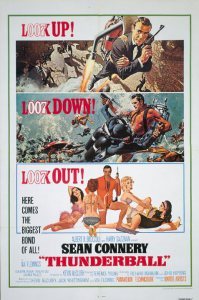 Bond’s old nemesis, S.P.E.C.T.R.E. — SPecial Executive for Counterintelligence, Terrorism, Revenge, and Extortion — is back with its most ambitious scheme yet. N.A.T.O. is conducting a training exercise with British long-range Vulcan bombers. S.P.E.C.T.R.E. has switched one of the officers aboard the Vulcan, Francois Derval, with their own man, whom they have had altered to look like Derval.
Bond’s old nemesis, S.P.E.C.T.R.E. — SPecial Executive for Counterintelligence, Terrorism, Revenge, and Extortion — is back with its most ambitious scheme yet. N.A.T.O. is conducting a training exercise with British long-range Vulcan bombers. S.P.E.C.T.R.E. has switched one of the officers aboard the Vulcan, Francois Derval, with their own man, whom they have had altered to look like Derval.
The imposter murders everyone aboard the plane, and then takes it down below radar and flies it across the Atlantic to the Bahamas, where he crash-lands it on the water. After it sinks, S.P.E.C.T.R.E. agents, led by Emilio Largo, murder the imposter (because he held out for more money) and steal the two atomic bombs off the plane. They then inform the British that if they don’t pay a 100-million-pounds ransom, one of the bombs will be exploded in an American or British city.
Every 00 agent in Europe, including James Bond, is called in to try to find the bombs before it’s too late. Bond is initially assigned to look in Canada, but he’s spied a clue in the briefing packet he gets. While he was drying out in the health clinic, Shrublands, he saw a dead man, whom at the time he did not know was Derval. The man’s sister Dominique, who goes by the nickname Domino, is in Nassau. Seeing it as the only lead they have, Bond requests he be reassigned to the Bahamas, and M agrees.
In Nassau, Bond makes contact with Domino and quickly discovers she is Largo’s girlfriend. Over a game of chemin de fer, Bond deduces Largo works for S.P.E.C.T.R.E., and he divides his time between trying to search Largo’s holdings (his estate, Palmyra, and his yacht, the Disco Volante) and the ocean around the island for the missing plane.
Bond and his regular ally, Felix Leiter, eventually locate the Vulcan, but the bombs are not aboard. With Domino’s help, Bond infiltrates Largo’s team and calls in the Marines, resulting in an epic underwater battle to foil S.P.E.C.T.R.E.’s plot once and for all.
The Feel
The ad campaign for Thunderball was, “Look up. Look down. Look out! Here comes the biggest Bond of them all!”
It’s absolutely spot-on. Where Goldfinger set the formula for all the films to come after it, Thunderball truly is the “biggest Bond of them all.” Every movie in the franchise after it attempts to capture the grandiose feel of this epic movie.
The sheer scope of the plot sets it apart from its predecessors. Two atomic bombs are stolen. The West is held h0stage for an outrageous sum of money. Though we don’t really see them, other 00’s are involved in the mission.
Furthermore, Largo is the first villain who can really match up with Bond on not only a mental but a physical level. Goldfinger and Dr. No were geniuses, but Largo is not only smart, he can pummel anyone he gets into a fight with. After the two men take the measure of each other several times, they finally struggle underwater, with Largo getting the better of Bond, and then again in the climactic fight aboard the bridge of Disco Volante. Largo appears to have Bond beaten until Domino kills her former lover, saving Bond in the process.
Thunderball also has a lot more sex than its predecessors. Bond has sex with three different women, and each occasion is provocative. After he is nearly killed at Shrublands, he blackmails his nurse into having sex with him to keep quiet about the incident. Despite the steam in the shower, we clearly see her disrobe.
He also beds S.P.E.C.T.R.E. agent Fiona Volpe. When he finds her in the bath in his suite and she asks him to give her something to put on, he hands her a pair of shoes. After their tryst, he tells her he got no pleasure from it, doing it only for King and Country.
And finally, he and Domino do it while scuba diving, causing Bond to remark afterward, “I hope we didn’t frighten the fish.”
What’s interesting about these conquests is that there’s no pretense of romance like in earlier films. He has sex with Domino solely and obviously to cement her assistance against Largo. He knows Fiona is working for S.P.E.C.T.R.E., but unlike Pussy Galore in Goldfinger and Tatiana Romanova in From Russia with Love, bedding her does not transform her into an ally. She continues to work for S.P.E.C.T.R.E. and hunts him ruthlessly through the Junkanoo — an island celebration similar to Mardi Gras.
Everything about Thunderball is big — the stakes, the plot, the women, and the cinematography. Thunderball is a gorgeous film, shot largely on location in the Bahamas. Director Terence Young masterfully handles an extraordinary amount of underwater photography — the giant commando raid at the end lasts nearly 12 minutes. Thunderball is a very wet film, and the fact that a movie of this scale was brought to the screen in only a year’s time is extraordinary by today’s standards.
Where It Fits
Like Goldfinger, Thunderball is a critically important film in the development of the franchise. As big as the plot of Goldfinger was, Thunderball raises the stakes and moves the ambitions of the villains to a more epic scale. From this point forward, the best Bond nemeses will be seeking to change the face of the Earth. Their visions are grand, their organizations far-reaching, and their schemes are apocalyptic.
After the success of Goldfinger, Bond pictures became lavish thrill-rides. Thunderball sets the standard for how big they had to be. The formula for the series is now set. Suave, sexually daring, and nearly invulnerable, James Bond is firmly established as an alpha-male good-guy. Every man wants to be him, every woman wants to date him, and the world needs him to keep it safe.
The last two films have permanently changed James Bond from a lethal and mysterious secret agent to a dashing superhero. Until Timothy Dalton takes the role in 1987’s The Living Daylights, this is how the character will be played and perceived.
Filed under: James Bond Tagged: James Bond, John Phythyon, Thunderball


May 7, 2015
Re-Viewing James Bond: Goldfinger
I continue my regular series on re-watching all the James Bond films prior to the November release of the newest, SPECTRE. This week, I’ve hit the James Bond movie, the one to which nearly all others pay homage — Goldfinger. As usual, I discuss the film’s plot and themes, so be advised there are spoilers.
The Plot
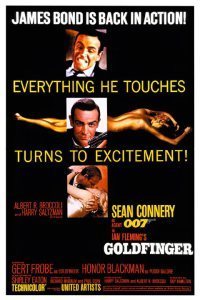 MI6 believes Auric Goldfinger, an international jet-setter, is illegally smuggling gold out of the UK. Goldfinger has considerable holdings, but since the price of gold varies from country to country, where it is bought and sold has a huge impact on its value and how much one can make with it. MI6 believes he is illegally moving it out of the country, so he can take advantage of better prices abroad without paying any tariffs.
MI6 believes Auric Goldfinger, an international jet-setter, is illegally smuggling gold out of the UK. Goldfinger has considerable holdings, but since the price of gold varies from country to country, where it is bought and sold has a huge impact on its value and how much one can make with it. MI6 believes he is illegally moving it out of the country, so he can take advantage of better prices abroad without paying any tariffs.
Despite Maud Adams’s claim 19 years later in Octopussy, international smuggling is very much the concern of the British Secret Service, so naturally, our hero, James Bond, is assigned to investigate. He is supposed to only observe, but when he catches Goldfinger cheating at gin, he can’t resist interfering.
That leads to a woman murdered and covered in gold paint, a golf match against Goldfinger in which Bond catches him cheating again, and a trip to the Swiss Alps where Bond is able not only to discover how Goldfinger is smuggling his gold but also that he is involved with a Chinese scientist in something called Operation: Grand Slam.
After he is captured and nearly emasculated with a laser beam, Bond is flown to Goldfinger’s Kentucky stud farm, where 007 learns that Goldfinger’s ultimate goal is to explode a nuclear device at Fort Knox, irradiating the gold deposits, so that the U.S. economy will crater (good for Red China) and Goldfinger’s own gold will increase in value.
The Feel
Goldfinger is absolutely over the top. It moves the James Bond franchise firmly out of the realm of serious espionage and fully into fantasy. Everything about this movie is about transforming Bond from deadly secret agent to confident superhero.
The opening, pre-title sequence has Bond emerging from the water with a fake seagull on his head to help provide cover. He wears a dinner jacket under his wetsuit. Shortly into the film’s main action, he beds Jill Masterson only to discover her lying dead in the nude, covered in gold paint.
Goldfinger’s plot is outrageous. Where Dr. No was attempting to topple U.S. rockets and S.P.E.C.T.R.E. was seeking to make money by playing the Brits and Soviets against each other, Goldfinger plans to explode a nuclear bomb on U.S. soil. And he doesn’t care about the politics. He’s just trying to increase the value of his gold.
Moreover, his employees are equally strange. His manservant, Oddjob, is mute and virtually unstoppable, becoming the prototypical privileged henchman. He kills with a razor-edged hat that he throws with deadly accuracy.
Then there is Goldfinger’s beautiful, personal pilot, Pussy Galore. Even Bond can’t resist pointing out how silly her name is by mugging for the camera and murmuring, “I must be dreaming,” when she introduces herself.
And then there are the gadgets. In From Russia with Love, he had the fantastic briefcase. In Goldfinger, in addition to homing devices that fit in his shoe heel, he gets the most famous car in the history of cinema — the Aston Martin DB5 with its machine guns under the headlights, oil slick and smokescreen in the back, and ejector seat.
Bond is no longer sneaking around, trying to find out who killed a colleague in Jamaica. He’s cutting a trail of destruction and outrageous heroism across the U.S. and Europe.
There are holes in it that detract. As amazing as Goldfinger’s plan is, it ignores certain important facts about nuclear bombs.
Goldfinger plans to irradiate the gold, so that it will be devalued. He obviously hasn’t read about the attacks on Hiroshima and Nagasaki, or he’d have known that the gold wouldn’t have been irradiated; it would have been slagged, along with the rest of Fort Knox. Given how fast the timer on the bomb is counting down, it doesn’t seem he is familiar with the concept of “minimum safe distance” either.
Moreover, since he claims the bomb is “very dirty,” millions of people in the South and the Eastern Seaboard and Midwest would have suffered from radiation poisoning.
It’s also tough to swallow that, once Pussy alerts Felix Leiter to the impending attack and switches out the Delta-9 nerve gas Goldfinger was planning to use to kill everyone so he could break into the base, that they would fake an entire army base of personnel being killed instead of just raiding Goldfinger’s compound.
And civilian planes are not allowed to fly over U.S. military bases without authorization, so Goldfinger’s plan to gas everyone would never have gotten off the ground, so to speak.
But at least at the time, most of these problems were ignored by audiences, which flocked to Goldfinger in record numbers.
Goldfinger opened on Christmas Day, 1964, and it was an immediate sensation. Some theaters stayed open 24 hours to accommodate the demand to see the picture. No one had seen anything like it, and it transformed the Bond series from a solid performer to a mega-franchise.
Where It Fits
Flaws aside, Goldfinger is the most important film in the entire series. Every movie that came after it has used Goldfinger as the model for its formula. (Indeed, 1985’s A View to a Kill adopts the plot almost point for point.) The structure is well defined in Lee Pfeiffer and Phillip Lisa’s excellent The Incredible World of 007 (Carol Publishing, 1995), and includes elements like “a spectacular pre-credits sequence often unrelated to the main plot,” “007’s involvement with a woman of dubious loyalty,” “a civilized duel of sorts between Bond and the main villain, usually in the form of game,” “an elaborate, high-speed chase,” and more.
Every single Bond film that comes after attempts to recreate Goldfinger. It is the pinnacle to which all others aspire.
Many, many Bond aficionados refer to it as the greatest movie in the series, although I disagree. First, there are the aforementioned plot holes, although I admit on this latest viewing that, despite the fact that Fort Knox would have been destroyed, not just irradiated, Goldfinger’s objectives would still be accomplished. His gold would increase in value, and Red China would have its Western economic crisis.
But Goldfinger also features a certain level of misogyny that doesn’t look very well 50 years on. Bond introduces his masseuse to Leiter, before dismissing her with a smack on the butt. Pussy Galore’s name is, well, offensive.
And Bond effectively rapes her at Goldfinger’s stud farm, forcing himself on her, only to have her acquiesce, thereby promulgating the myth that what women really want is a man to dominate them. The message is more egregious in Goldfinger, because Pussy switches sides to Bond’s after he forces her to have sex with him.
Goldfinger is not a perfect film, and in my opinion, there are multiple entries in the series that are vastly superior in terms of plot and theme. But is unquestioningly the most important picture in the franchise — setting the mold for everything that comes after it.
Filed under: James Bond Tagged: Goldfinger, James Bond, John Phythyon





